|
Overview of the monuments in Dinant
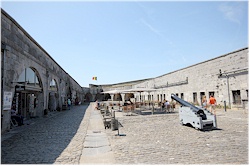 Citadel.
The place where the town of Dinant is located has always been a
place of strategic importance; therefore it shouldn't be a
surprise to know that on the spot of the current citadel, there
already used to be a castle in the 11th century. In its present
form, the citadel only dates back to 1821, when it was
constructed by the Dutch. The citadel can be visited and hosts a
museum inside. On top of that, you have a great panoramic view
on the town and the Meuse that are located at its feet [more
information]. Citadel.
The place where the town of Dinant is located has always been a
place of strategic importance; therefore it shouldn't be a
surprise to know that on the spot of the current citadel, there
already used to be a castle in the 11th century. In its present
form, the citadel only dates back to 1821, when it was
constructed by the Dutch. The citadel can be visited and hosts a
museum inside. On top of that, you have a great panoramic view
on the town and the Meuse that are located at its feet [more
information].
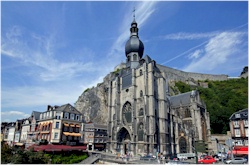 Collegiate
church.
The collegiate church is unique because of its specific spire in
pear shape and has become a symbol for the town of Dinant. She
stands practically entirely against the rock formation behind
it. This had dramatic consequences in the 13th century when a
part of the rock fell down on the building. Inside the Ladon
stained glass window, one of the largest in its kind in Europe,
is a real eye-catcher. The bust of Saint-Perpetuus is exquisite
and is displayed on a prominent spot inside the sanctuary [more
information]. Collegiate
church.
The collegiate church is unique because of its specific spire in
pear shape and has become a symbol for the town of Dinant. She
stands practically entirely against the rock formation behind
it. This had dramatic consequences in the 13th century when a
part of the rock fell down on the building. Inside the Ladon
stained glass window, one of the largest in its kind in Europe,
is a real eye-catcher. The bust of Saint-Perpetuus is exquisite
and is displayed on a prominent spot inside the sanctuary [more
information].
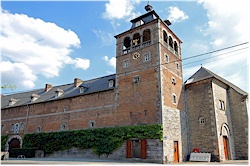 The
abbey of Leffe. The abbey of Leffe was founded by
the abbey of Floreffe and became independent in 1200. At the
time of the pillage of Dinant in 1466 by Charles the Bold, the
abbey was also severely damaged. During the French occupation in
1796, the entire domain was confiscated and sold publically. It
was not until 1903 when clergy again inhabited the premises;
this time it were monks that fled from France. After them, Leffe
was taken over by the abbey of Tongerloo. Leffe is very well
known because of its beers. Since a few years, a "Maison de
Leffe" has opened its doors near the center of the town. The
abbey of Leffe. The abbey of Leffe was founded by
the abbey of Floreffe and became independent in 1200. At the
time of the pillage of Dinant in 1466 by Charles the Bold, the
abbey was also severely damaged. During the French occupation in
1796, the entire domain was confiscated and sold publically. It
was not until 1903 when clergy again inhabited the premises;
this time it were monks that fled from France. After them, Leffe
was taken over by the abbey of Tongerloo. Leffe is very well
known because of its beers. Since a few years, a "Maison de
Leffe" has opened its doors near the center of the town.
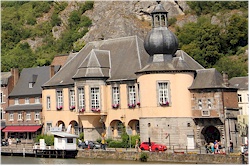 Town
hall of Dinant. The present town hall is in fact
already the fourth one the town had. A predecessor was even
built on the brigde over the river Meuse. In 1783, the town
council moved into the former palace that the prince-bishop of
Liege had built in Dinant. That building burned down in 1914 but
was reconstructed in its original state after the war. On the
inner square you can find the monument for the victims of both
World Wars and a sculpture in glass that is an ode to as well
the saxophone as the Meuse river. Town
hall of Dinant. The present town hall is in fact
already the fourth one the town had. A predecessor was even
built on the brigde over the river Meuse. In 1783, the town
council moved into the former palace that the prince-bishop of
Liege had built in Dinant. That building burned down in 1914 but
was reconstructed in its original state after the war. On the
inner square you can find the monument for the victims of both
World Wars and a sculpture in glass that is an ode to as well
the saxophone as the Meuse river.
Porte Saint-Martin.
This is the only remaining town gate of Dinant. The town hall is
built adjacent to this gate. An inscription that indicated the
year 1637 reminds of the neutral status that the town had during
the 30 years war. Freely translated, it says: peace and health
is given to those who serve neutrality.
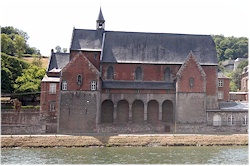 Cloister
of the Capucins.
This cloister was built in 1613. In 1797, the buildings were
confiscated by the French occupier and ended up in the hands of
the town administration that wanted to turn the premises into an
orphanage. The whole consists of three wings and has
single-aisle chapel. Cloister
of the Capucins.
This cloister was built in 1613. In 1797, the buildings were
confiscated by the French occupier and ended up in the hands of
the town administration that wanted to turn the premises into an
orphanage. The whole consists of three wings and has
single-aisle chapel.
Monument
for the martyrs.
In August 1914, Dinant was the stage of a real massacre.
When the German army in first instance couldn't conquer the town,
they succeeded after all in their objective on 22 August.
As revenge for the delay in their push and out of fear for
partisans under the civilian population, a large number of
civilians were shot. In the end there were 674 victims.
This tragedy is known in the history as the Dinant massacre ("le massacre de Dinant").
A monument commemorating the martyrs (of both World Wars) has
been erected on the square in front of the town hall.
|




